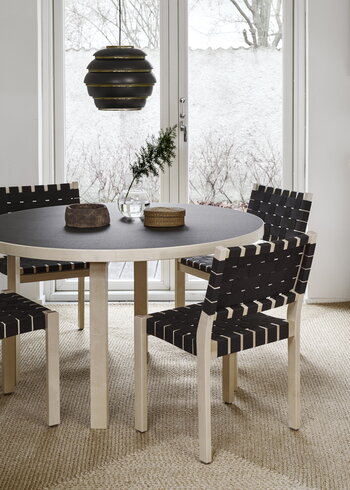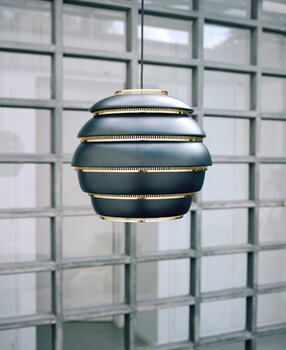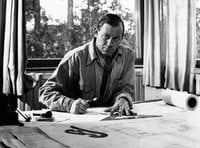Artek’s A331 pendant light is a beloved classic designed by Alvar Aalto in 1953. Also known as the Beehive, the pendant was first introduced as part of the décor of the University of Jyväskylä, and has, over time, become one of Artek’s most popular lamps. The long-awaited black version of the Beehive was released in 2018. It consists of a black aluminum shade and brass-colored rings that filter the light in the most beautiful manner. Beehive is a fine example of Aalto's fascination with indirect light and organic forms, and a tasteful addition to any room.
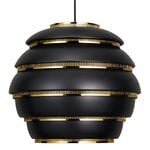
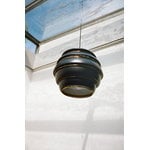

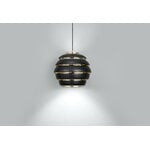
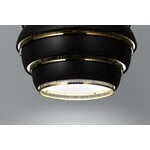
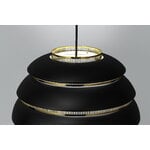
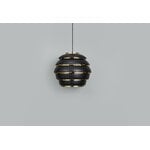
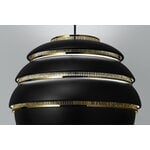
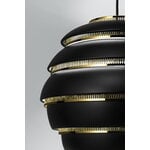
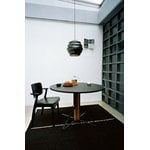

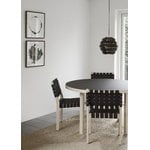
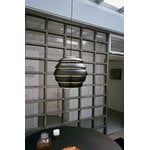

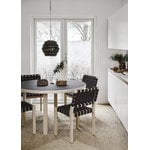
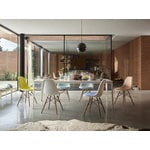
Aalto pendant A331 "Beehive", black - brass
Artek
Description
Artek’s A331 pendant light is a beloved classic designed by Alvar Aalto in 1953. Also known as the Beehive, the pendant was first introduced as part of the décor of the University of Jyväskylä, and has, over time, become one of Artek’s most popular lamps. The long-awaited black version of the Beehive was released in 2018. It consists of a black aluminum shade and brass-colored rings that filter the light in the most beautiful manner. Beehive is a fine example of Aalto's fascination with indirect light and organic forms, and a tasteful addition to any room.
Product details (17)
- Material
- Painted aluminum
- Colour
- Black, brass
- Width
- 12.99 in (33 cm)
- Diameter
- 12.99 in (33 cm)
- Height
- 11.81 in (30 cm)
- Bulb base
- E27
- Light source
- 9-12W LED (not included)
- IP rating
- 20
- Protection class
- II
- Voltage
- 220–240 V
- Nominal frequency
- 50–60 Hz
- Certifications and labels
- CE marked: tested and approved according to European standards
- Cable length
- 98.43 in (250 cm)
- Cable colour
- Black
- Cable material
- Plastic
- Canopy
- Included
- Ceiling plug
- No
- Product ID
Designer
Alvar Aalto (1898-1976) is probably the most famous Finnish architect and designer in the world. In 1921 Alvar Aalto got the Diploma of Architecture at the Helsinki Institute of Technology and his career as an architect started. One of the most important works he was commissioned was the planning of the tuberculosis sanatorium in Paimio, Finland. This project meant also the beginning of Aalto’s career as a furniture designer – in fact, this was the first building planned by Aalto which was entirely furnished with pieces of furniture designed by Aalto himself – including the lighting as well. Other important projects completed by Alvar Aalto are the Viipuri Municipal Library, Villa Mairea, La Maison Carré and the Finnish Pavilions for the 1937 Paris and 1939 New York World Fairs.
In 1935 Alvar Aalto, together with Aino Aalto, Maire Gullichsen and Nils-Gustav Hahl, founded Artek, a world-renowned furniture and lighting company. The company was created "to sell furniture" – designed by Alvar Aalto – "and to promote modern culture of habitation by exhibitions and other means".
One of the most ingenious innovations by Alvar Aalto is the L-leg, patented in 1933. Aalto considered his L-leg design his greatest achievement and even compared it to the invention of the architectonic column. Thanks to this innovation, the legs could be attached directly to the table, chair and stool tops. Alvar Aalto was a versatile designer whose work covered different fields. He is well-known also for his elegant lamps, which very often were designed for individual construction projects and later on adapted for the serial production. Alvar Aalto was also an esteemed glass designer and his most famous work as a glass designer is the Aalto vase (or Savoy vase) – one of the most iconic glassware pieces in Finnish design.
Would you like to read more about Alvar Aalto and his work? Discover our books:
Aalto, Alvar Aalto Homes, Alvar Aalto Libraries, Alvar Aalto Designer, Alvar Aalto – The Mark of the Hand, Alvar Aalto – A Gentler Structure for Life, Alvar Aalto Architect vol. 5, Alvar Aalto Architect vol. 18, Alvar Aalto Architect vol. 20, Iittala, Atlas of Mid-Century Modern Houses, Mid-Century Modern Design, Modernist Escapes: An Architectural Travel Guide
Reviews (15)
5
Based on 15 reviews
-
T
Tapani M
Finland
Samat kommentit kuin edelliseen ja lisäksi näyttää että messinkirenkaat ja maalatut osat hiukan pykältää / ei ole linjassa.
430 days ago
-
E
Elina V
Espoo, Finland
Todella kaunis valaisin.
198 days ago
-
A
anonyymi
Tampere, Finland
Upea!
157 days ago
Sustainability
The Product Sustainability Framework, our criteria of sustainable design, helps you find the most sustainable products in our selection. Read below which sustainability criteria this product has met.
Working conditions & labour 7/9
-
Equal opportunities for all employees
-
Commitment to UN Global Compact, fair compensation for all employees
-
Corporate responsibility requirements defined and communicated for suppliers
-
Systematic work for improved inclusion and well-being in the workplace
-
Transparent supply chain
-
Suppliers' compliance to a code of conduct ensured
-
Compliance to the UN Guiding Principles on Business and Human Rights ensured in the supply chain
-
Direct suppliers audited and certified
-
Support for community involvement in the supply chain
Eco-friendly production 7/9
-
Fair and resource-wise water-use in production
-
No incineration or landfilling of returned items
-
No use of endangered species as materials
-
No direct environmental emissions or waste (excl. GHGs) from production
-
Production and material sourcing that respect biodiversity, animal rights, and natural ecosystems
-
Material-efficient and ecological packaging
-
No potentially harmful chemicals used in own production
-
The sustainability of direct suppliers' production is addressed and monitored
-
Positive impact on nature’s well-being through operations that regenerate natural ecosystems
Climate impact 5/8
-
Company's direct greenhouse gas emissions identified and commitment to reduction
-
Product's carbon impact identified and commitment to reduction
-
Guidance on energy- and eco-efficient use of the product
-
Contribution to climate initiatives beyond the brand’s direct operations
-
100 % renewable energy in own production and operations
-
Low-carbon or compensated transportation
-
Carbon footprint of the product calculated and goals set to reduce it
-
Carbon neutral or carbon negative product
Sustainable materials 6/6
-
Sustainable and long-lasting material choices
-
No harmful or hazardous substances
-
Responsible raw material sourcing and production
-
Materials suited for circularity: monomaterials, recyclable finishings, renewable or recycled contents etc.
-
Ecological materials: natural, biodegradable, recyclable or recycled contents
-
Outstanding materials in terms of innovativeness, responsibility, sustainability and circularity: local production or sourcing, 100 % recycled content, C2C-certification etc.
Circular design 5/5
-
High aesthetic quality promoting long-term use of the product
-
Technically durable product design and material choices
-
Design for enduring life-long quality
-
Design and support for product maintenance, repair and upgradability
-
Innovative circular design solutions: circular service system, resale platform, remanufacturing, collection of used products, etc.









